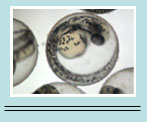

Home
Common Techniques
Classroom Experiments
Virtual Experiments
Tutorials
Games
Glossary
Links
Publishing
Opportunities
About This Site
Contact Us
ZFIN
Cite Us
Microinjection of Zebrafish Embryos
Download the pre-lab worksheet
Introduction: Microinjection of Zebrafish Embryos
In developmental biology as well as in other biological research, molecules are oftentimes physically introduced into cells of developing organisms. This technique, called microinjection, is commonly used to alter gene expression. Microinjection allows genes (DNA), mRNA and antisense morpholinos with solution to be directly injected into the nucleus of a cell. Since the developing zebrafish embryo nucleus is relatively large, this technique is particularly practical.
In this experiment, you will use the technique of microinjection to insert antisense morpholino oligos into the developing zebrafish embryo. Morpholino oligomers will reduce the amount of chordin, an anti-BMP (bone morphogenetic protein), that is normally produced in the developing embryo. The goal of this experiment is to both learn and master the technique of microinjection and also to learn about the role of BMP signaling during early zebrafish development.
BMP is responsible for inducing certain parts of the embryonic ectoderm to become epidermal tissue rather than neural tissue. The nervous system forms from the ectoderm region that is protected from BMP-binding and thus from becoming epidermis. Therefore, the “default” fate of the ectoderm is to become neural tissue. The organizer of the developing embryo secretes molecules that block BMPs, therefore protecting certain parts of the ectoderm against the effects of BMPs and allowing those parts of the ectoderm to become neural tissue. The three major BMP inhibitor molecules secreted by the organizer are Noggin, chordin and follistatin.
Chordin, an anti-BMP protein, is an organizer protein that is commonly found in the dorsal zone of a developing embryo, including the dorsal blastopore lip and later in the notochord. Chordin prevents BMPs from binding to certain parts of the embryonic ectoderm, allowing it to develop into neural tissue as opposed to epidermal tissue. Morpholino antisense oligomers block the translation of chordin mRNA into protein, preventing its ability to block BMP binding. This causes notable changes in the development of an embryo.
You will be injecting a solution of morpholino antisense oligomers into the developing zebrafish embryo and observing its effects on zebrafish development. Through doing this experiment you will also gain an understanding of BMP signaling, the importance of anti-BMPs in development, and the effects of morpholino antisense oligomers on BMP signaling pathways.
Instructor Information
This experiment is appropriate for students who have a fairly strong background in developmental biology and previous work with zebrafish embryos. Microinjection is a technique that requires much precision and patience, so prior laboratory experience is a must. Therefore, this experiment is appropriate for students in advanced developmental biology courses. Students may work in groups or independently, according to the amount of available microinjectors. Since morpholinos are expensive, it is a good idea to have students practice microinjection first with a mock injection solution.
Equipment needed
- Microinjector
- Dissecting scope
Materials needed
- Glass microinjection needles
- Agarose injection dishes
- Blunt Pasteur pipettes or embryo loops for pushing embryos
- Petri plates containing living embryos at early cleavage stages in E3
- Dissecting forceps
- P10 micropipettors and disposable tips
- Aliquots of mock injection solution (red) and morpholino solution (green)
Techniques used
- Microinjection
- Use of embryo loops
- Use of dissecting stereomicroscope